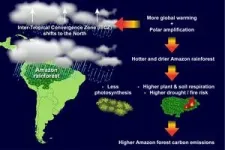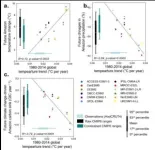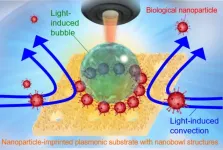(Press-News.org)
Fukuoka, Japan—Researchers have developed a new organic thermoelectric device that can harvest energy from ambient temperature. While thermoelectric devices have several uses today, hurdles still exist to their full utilization. By combining the unique abilities of organic materials, the team succeeded in developing a framework for thermoelectric power generation at room temperature without any temperature gradient. Their findings were published in the journal Nature Communications.
Thermoelectric devices, or thermoelectric generators, are a series of energy-generating materials that can convert heat into electricity so long as there is a temperature gradient—where one side of the device is hot and the other side is cool. Such devices have been a significant focus of research and development for their potential utility in harvesting waste heat from other energy-generating methods.
Perhaps the most well-known use of thermoelectric generators is in space probes such as the Mars Curiosity rover or the Voyager probe. These machines are powered by radioisotope thermoelectric generators, where the heat generated from radioactive isotopes provides the temperature gradient for the thermoelectric devices to power their instruments. However, due to issues including high production cost, use of hazardous materials, low energy efficiency, and the necessity of relatively high temperatures, thermoelectric devices remain underutilized today.
“We were investigating ways to make a thermoelectric device that could harvest energy from ambient temperature. Our lab focuses on the utility and application of organic compounds, and many organic compounds have unique properties where they can easily transfer energy between each other.” explains Professor Chihaya Adachi of Kyushu University’s Center for Organic Photonics and Electronics Research (OPERA) who led the study. “A good example of the power of organic compounds can be found in OLEDs or organic solar cells.”
The key was to find compounds that work well as charge transfer interfaces, meaning that they can easily transfer electrons between each other. After testing various materials, the team found two viable compounds: copper phthalocyanine (CuPc) and copper hexadecafluoro phthalocyanine (F16CuPc).
“To improve the thermoelectric property of this new interface, we also incorporated fullerenes and BCP,” continues Adachi. “These are known to be good facilitators of electron transport. Adding these compounds together significantly enhanced the device’s power. In the end, we had an optimized device with a 180 nm layer of CuPc, 320 nm of F16CuPc, 20 nm of fullerene, and 20 nm of BCP.”
The optimized device had an open-circuit voltage of 384 mV, a short-circuit current density of 1.1 μA/cm2, and a maximum output of 94 nW/cm2. Moreover, all these results were achieved at room temperature without the use of a temperature gradient.
“There have been considerable advances in the development of thermoelectric devices, and our new proposed organic device will certainly help move things forward,” concludes Adachi. “We would like to continue working on this new device and see if we can optimize it further with different materials. We can even likely achieve a higher current density if we increase the device’s area, which is unusual even for organic materials. It just goes to show that organic materials hold amazing potential.”
###
For more information about this research, see “Organic Thermoelectric Device Utilizing Charge Transfer Interface as the Charge Generation by Harvesting Thermal Energy," Shun Kondo, Mana Kameyama, Kentaro Imaoka, Yoko Shimoi, Fabrice Mathevet, Takashi Fujihara, Hiroshi Goto, Hajime Nakanotani, Masayuki Yahiro, and Chihaya Adachi, Nature Communications, https://doi.org/10.1038/s41467-024-52047-5
About Kyushu University
Founded in 1911, Kyushu University is one of Japan's leading research-oriented institutes of higher education, consistently ranking as one of the top ten Japanese universities in the Times Higher Education World University Rankings and the QS World Rankings. The university is one of the seven national universities in Japan, located in Fukuoka, on the island of Kyushu—the most southwestern of Japan’s four main islands with a population and land size slightly larger than Belgium. Kyushu U’s multiple campuses—home to around 19,000 students and 8000 faculty and staff—are located around Fukuoka City, a coastal metropolis that is frequently ranked among the world's most livable cities and historically known as Japan's gateway to Asia. Through its VISION 2030, Kyushu U will “drive social change with integrative knowledge.” By fusing the spectrum of knowledge, from the humanities and arts to engineering and medical sciences, Kyushu U will strengthen its research in the key areas of decarbonization, medicine and health, and environment and food, to tackle society’s most pressing issues.
END
The superior colliculus is a midbrain region that is traditionally thought to help animals orient themselves toward important locations in space, like directing their eyes and head toward a bright flash of light. New research from the University of Chicago shows that this part of the brain also plays a role in complex cognitive tasks like visual categorization and decision making.
In the new study, published in Nature Neuroscience, scientists measured the information contained in patterns of brain cell activity across multiple brain regions involved in visual category decisions. The researchers monitored activity in the superior colliculus (SC) and part of the posterior parietal ...
Lavas from hotspots—whether erupting in Hawaii, Samoa or Iceland—likely originate from a worldwide, uniform reservoir in Earth’s mantle, according to an evaluation of volcanic hotspots published today in Nature Geoscience.
The findings indicate Earth’s mantle is far more chemically homogenous than scientists previously thought—and that lavas only acquire their unique chemical “flavours” enroute to the surface.
“The discovery literally turns our view of hotspot lavas and the mantle upside down,” said Dr. Matthijs Smit, associate professor ...
The Amazon, often called the "lungs of the planet", is the world’s largest tropical forest, playing a crucial role in the global climate system due to its vast carbon storage. While it is typically warm and humid all year round, continued climate change poses the threat of more frequent and severe droughts and heat extremes. A new study, published in Nature Communications delves into future projections of the Amazon carbon cycle, focusing specifically on the impacts driven by climate change.
Scientists use the latest generation of Earth system models from the Coupled Model Intercomparison Project which contributed to ...
A new way of making ammonia by harnessing the unique power of liquid metal could lead to significant cuts in carbon emissions caused by production of the widely-used chemical.
Ammonia is used in fertiliser to grow much of our food, but also plays a role in clean energy as a carrier to safely transport hydrogen.
The global production of ammonia, however, comes at a high environmental cost: it consumes over 2% of global energy and produces up to 2% of global carbon emissions.
RMIT Research Fellow and study ...
Researchers have uncovered a fascinating mechanism behind the reduction and asymmetry of emu wing bones. The wings not only show significant shortening, but the skeletal elements also fuse asymmetrically, a phenomenon traced back to the absence of muscle formation in the distal regions of the wings. During development, this lack of muscle leads to insufficient mechanical stress, which is crucial for proper bone formation. The team identified muscle progenitor cells with a unique dual identity, combining characteristics of both somite1-derived myogenic and lateral plate mesoderm2 cells. These ...
Only about ten percent of the world’s roughly 4,000 snake species have venom strong enough to seriously hurt a human, but that’s enough for snake bites to be an important public health concern. To help better understand how snakes make their venom and how venoms differ from one species to another, researchers developed a new way to zero in on the genes that snakes use in venom production. Their work was published in the journal Molecular Ecology Resources.
“We’ve developed a tool that can tell us which venom-producing genes are present across an entire snake family in one fell swoop,” says Sara Ruane, the Assistant Curator of Herpetology in the ...
· Daily homework of up to 15 minutes most effective for maths achievement
· Homework assigned three to four times a week benefits science performance
· Short duration homework just as effective as longer assignments
Researchers at Maynooth University’s Hamilton Institute and Department of Mathematics and Statistics in Ireland have unveiled significant findings on the role of homework in student achievement. The research, led by Prof Andrew Parnell, Nathan McJames and Prof Ann O’Shea, used a new AI model to analyse data from the Trends in International Mathematics and Science ...
A new paper in Oxford Open Climate Change, published by Oxford University Press, uncovers evidence suggesting that, contrary to expectations, most U.S. cities are not doing too badly in avoiding development in areas prone to flooding, and those that are effective appear to be applying existing tools and strategies well, rather than doing anything particularly novel.
Despite billions of dollars of investments and widespread mitigation efforts, the costs of disasters in the United States have grown dramatically. ...
Like moths to a flame, microbes can also be moved by light. Using this knowledge, researchers from Osaka Metropolitan University’s Research Institute for Light-induced Acceleration System (RILACS) have demonstrated a method to detect the presence of viruses quickly and using only a small sample.
The research team led by OMU Professor Takuya Iida, the director of RILACS, and Associate Professor Shiho Tokonami, the deputy director, report in npj Biosensing on a light-induced immunoassay. Using ...
Part of many people’s pandemic experience included working from home. Even after lockdowns, videoconferencing remains a big part of life as people continue to work remotely, connect with families and friends online, and attend virtual events hosted on videoconferencing platforms.
Spending hours on video calls, however, can be exhausting and manifest as physical, emotional, or cognitive tiredness – a phenomenon known as videoconferencing fatigue (VF). Now, researchers in Singapore have asked if a relationship between virtual backgrounds and VF exists and ...







